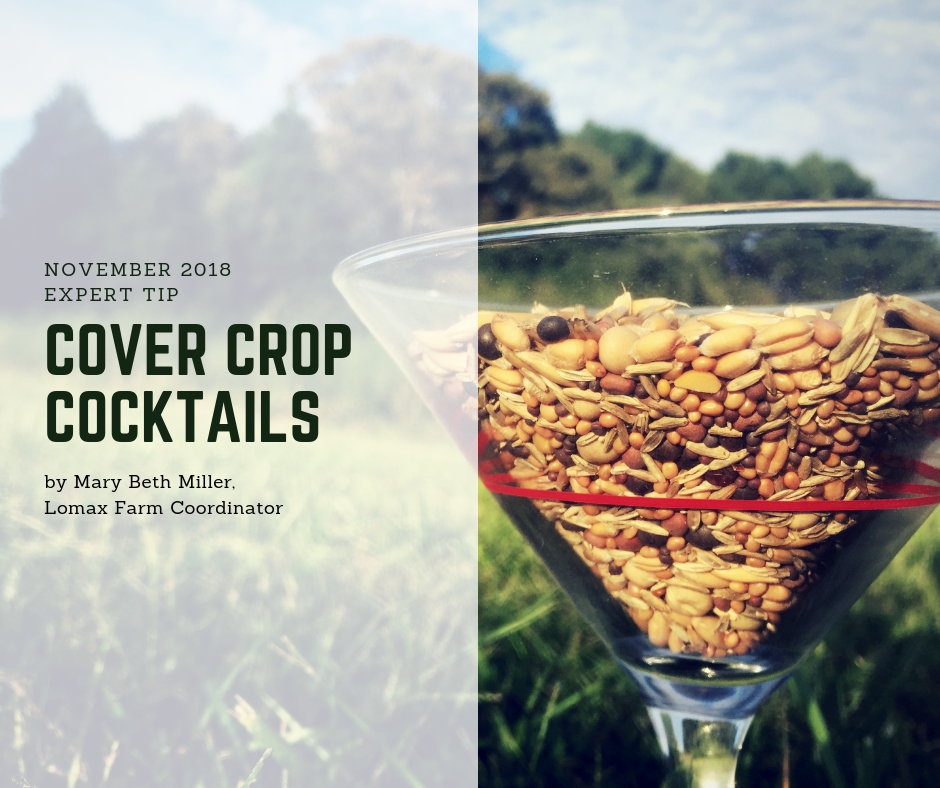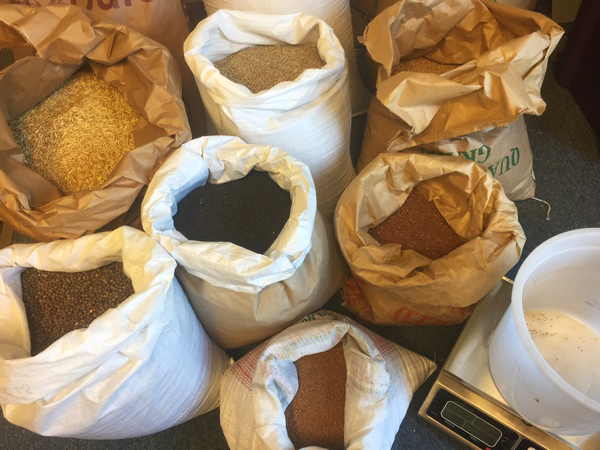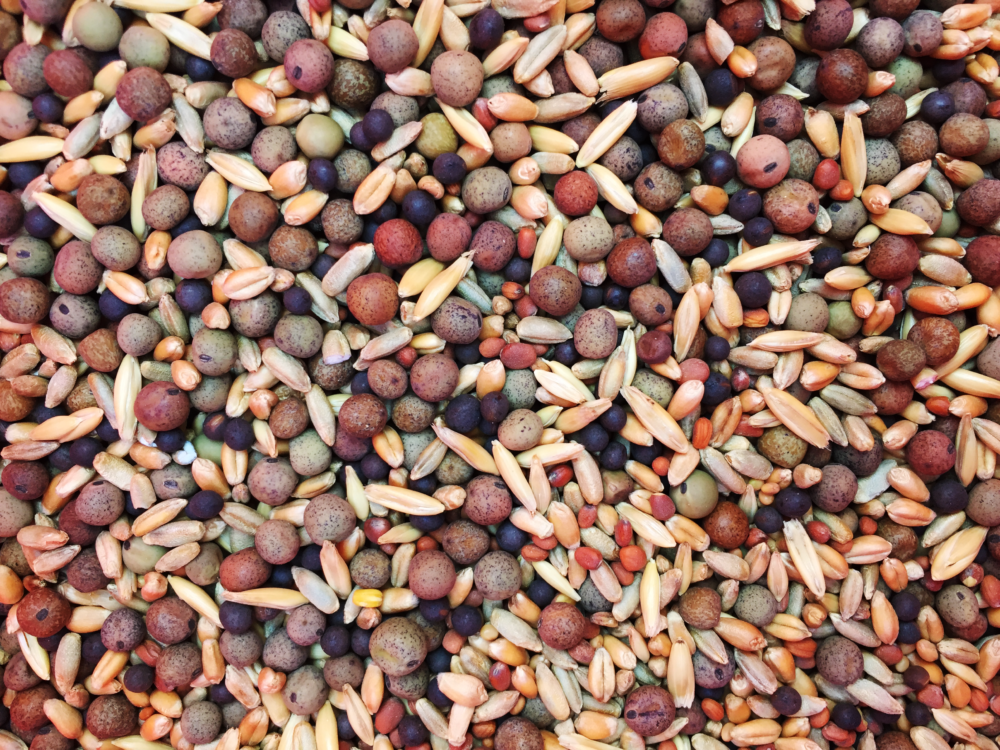By Mary Beth Miller, Lomax Farm Coordinator | Nov. 19, 2018 –
By now, if you planned to incorporate fall cover crops in your field rotation this year, they are most likely already in the ground and well-established.
At Lomax Farm (CFSA’s education and research farm) in Concord, NC, we wrapped up the last round of cover cropping a few weeks ago. Lomax has a little over nine acres of production fields, and between our on-farm research, educational demonstrations, and field rotations, we do a lot of cover cropping throughout the year. This fall, we decided to experiment with making our own cover crop “cocktails” – specific blends that suit the needs and management objectives of each field.
Why use cover crop mixes?
Individual species of cover crops have different strengths and weaknesses. For example:
- Forage radish excels at suppressing weeds and reducing compaction in the fall, but because it winter kills, it doesn’t provide living roots throughout the winter or residue cover the following spring.
- Cereal rye is the best cool-season cover for scavenging nitrogen but can deprive crops of nitrogen in the spring.
- Hairy vetch is excellent at delivering nitrogen and weed suppression in the spring, but grows slowly in the fall and may fall short in smothering weeds.
By planting several cover crops together you can avoid the pitfalls of monocultures and reap the benefits of multiple species.
As with cash crops, factors such as weather, soil conditions, and management decisions will affect a cover crop’s performance. Planting two or more species of cover crops that are functionally redundant (such as hairy vetch and crimson clover for nitrogen, or oats and rye for weed suppression), will ensure that at least one of the cover crops serves its management function.
Why we like making our own mixes
- Customization. Each of Lomax’s 35 fields has a unique history, with varying degrees of nutrient deficiencies, compaction, soil erosion, and weed, pest, and disease pressure. We can create unique mixes that target specific issues for each field.
- Timing. Mixes allow us more flexibility on the planting date. Since the ideal time for planting cover crop varies, planting a mixture ensures that at least a few varieties will establish if we have to plant earlier or later than expected. The same is true when terminating in the spring.
- Seeding. We don’t have a grain drill, therefore all of our cover crop seeding is done with a shoulder spreader. Seeds can vary–in weight and size–and have a tendency to separate in a mixture; we avoid this by keeping the seeds separate by size and weight and doing two passes with the broadcast spreader to allow a more even distribution.
- Cost. Cover cropping can be expensive, even for just a few acres, especially when purchasing certified organic seed. By making our own mixes, we can incorporate less expensive cover crops, such as winter rye, with more expensive covers, such as hairy vetch, and still see benefits from both. Additionally, if buying in bulk, we save money by making our own mixes compared to buying the commercially available blends from seed companies.
Comparing the cost
In the past, we have used Johnny’s Fall Green Manure Mix, which is comprised of winter rye, field peas, ryegrass, crimson clover, and hairy vetch. The mix has good germination, and we’ve been very pleased with the results. However, a 50-pound bag costs $99.50 (without tax or shipping), making the mix around $2.00 per pound. If you add on the cost of shipping (an extra $30-$60 per bag), then the price becomes cost-prohibitive if you have more than an acre to cover. We compared the cost of the Johnny’s mix to the one that we made with seed sourced from a local supplier.
Below is a breakdown of the mix by percentage of each specified crop.
50 lb. bag of Johnny’s Fall Green Manure Mix
| Cover Crop | % | Lbs. |
| Winter Rye | 40 | 20 |
| Forage Peas | 30 | 15 |
| Ryegrass | 10 | 5 |
| Crimson Clover | 10 | 5 |
| Hairy Vetch | 10 | 5 |
| Total | 100 | 50 |
50 lbs. of Lomax’s fall green manure mix with seed from a local supplier:
| Cover Crop | % | Lbs. | $/Lb. (non-OG) | $/Lb. (OG) | Cost per 50 lb. (non-OG) | Cost per 50 lb. (OG)* |
| Winter Rye | 40 | 20 | $0.60 | $1.00 | $12.00 | $20.00 |
| Austrian Winter Peas | 30 | 15 | $1.00 | $1.95 | $15.00 | $29.25 |
| Ryegrass | 10 | 5 | $1.26 | NA | $6.30 | $6.30* |
| Crimson Clover | 10 | 5 | $1.90 | NA | $9.50 | $9.50* |
| Hairy Vetch | 10 | 5 | $3.50 | $3.95 | $17.50 | $19.75 |
| Total | 100 | 50 | —- | —- | $60.03 | $84.80 |
*Where certified organic seed was not available, a non-treated, conventional seed was substituted.
As you can see, we made the same mix for 60% of the price of the Johnny’s mix and roughly 85% of the price choosing the available certified organic options. We can also change the mix to include more or fewer varieties to suit the needs of each field. Buying in bulk (50 pounds or more) also reduces the cost of making mixes if you have multiple acres to cover.
Calculating seeding rates for mixes
The type of mix that you make will depend on the management needs for a specific field. For Field “X,” we want to address the following issues:
- Nitrogen deficiency
- Annual and perennial weeds
- Soil compaction
For this field, we chose a mixture of Austrian winter pea, hairy vetch, crimson clover, oats, cereal rye, and forage radish.
- The oats and radishes will establish quickly, provide early ground cover for weeds, break up heavy soil, and winter kill.
- The cereal rye will establish later and remain through the winter. When it starts to warm up, the rye will provide stems for lateral growth of the vetch and peas while the legumes will combat the rye’s tendency to tie up nitrogen in the spring.
- The crimson clover will bloom in the spring as early forage for pollinators.
Fall Cover Crop Mix for Field “X” (0.5 Acres)
|
Cover Crop |
Plot Size (A) |
Multiply by Monoculture Broadcast Rate (Lbs./A) | Multiply by Reduced Rate for Mixes (%) | Divide by Functional Redundancy |
= Lbs. in the Mixture |
| Austrian Winter Pea | 0.5 | 140 | 0.8 | 3 | 18.6 |
| Hairy Vetch | 0.5 | 35 | 0.8 | 3 | 4.6 |
| Crimson Clover | 0.5 | 30 | 0.8 | 3 | 4.0 |
| Oats | 0.5 | 160 | 0.25 | 2 | 10 |
| Cereal Rye | 0.5 | 150 | 0.5 | 2 | 18.75 |
| Forage Radish | 0.5 | 10 | 0.2 | 1 | 1.0 |
Important notes for calculating mixes:
- Most seeding rates listed on cover crop labels are for planting with a grain drill. Seeding rates must be adjusted for broadcasting, which is typically 50-100% more than drilling rates.
- Some species are more competitive than others and their seeding rates must be adjusted accordingly so as not to outcompete other species in the mix. For instance, oats and cereal rye are highly competitive, so their rates should be kept below a threshold when mixed with other cover crops. On the other hand, legumes are weak competitors and should be kept close to their monoculture rate. (Refer to the resources at the end of this article for adjusted seeding rates for mixes).
- When planting two or more species that are “functionally redundant,” seeding rates should be reduced even further. For example, if planting the three legumes Austrian winter pea, hairy vetch, and crimson clover, divide the rate by three.
Example Calculation:
Austrian Winter Pea
(0.5 A) x (140 Lbs./A) x (0.8) / (3) = 18.6 Lbs.
Considerations for making the most out of your mix
Termination. There are drawbacks to using cover crop mixes, among them is the tradeoff between different benefits when it comes time to terminate. In a mix with multiple species, the optimum maturity stage can be weeks, if not months, apart. For example, allowing certain cover crops such as hairy vetch to flower long enough could result in undesirable seed banks, and as grasses mature they can be hard to incorporate into the soil. One way to combat this is to choose complementary species with similar growth periods.
Competition. Different species will compete for space and light, ultimately reducing the benefits of the weaker species. Choosing species with similar or complementary growth forms (tall canopy, short canopy, or vining), and reducing the seeding rate of stronger species will help alleviate competition.
Ultimately, cover crop mixes can be as simple or as complex as you want them to be. If you decide to use a cover crop polyculture, which can be as straightforward as a rye-pea mix, consider your management needs and make intentional selections. Creating your own mixes allows you to customize them to fit your field’s needs, plant with a more flexible schedule, ensure good establishment when broadcasting, and reduce your overall costs.
For more information and research on making cover crop mixes, please refer to:
- Penn State’s Multifunctional Cover Crop Cocktails for Organic Systems
- Penn State’s Making the Most of Mixtures
- NRCS’s On-Farm Field Trials Using Cover Crops





